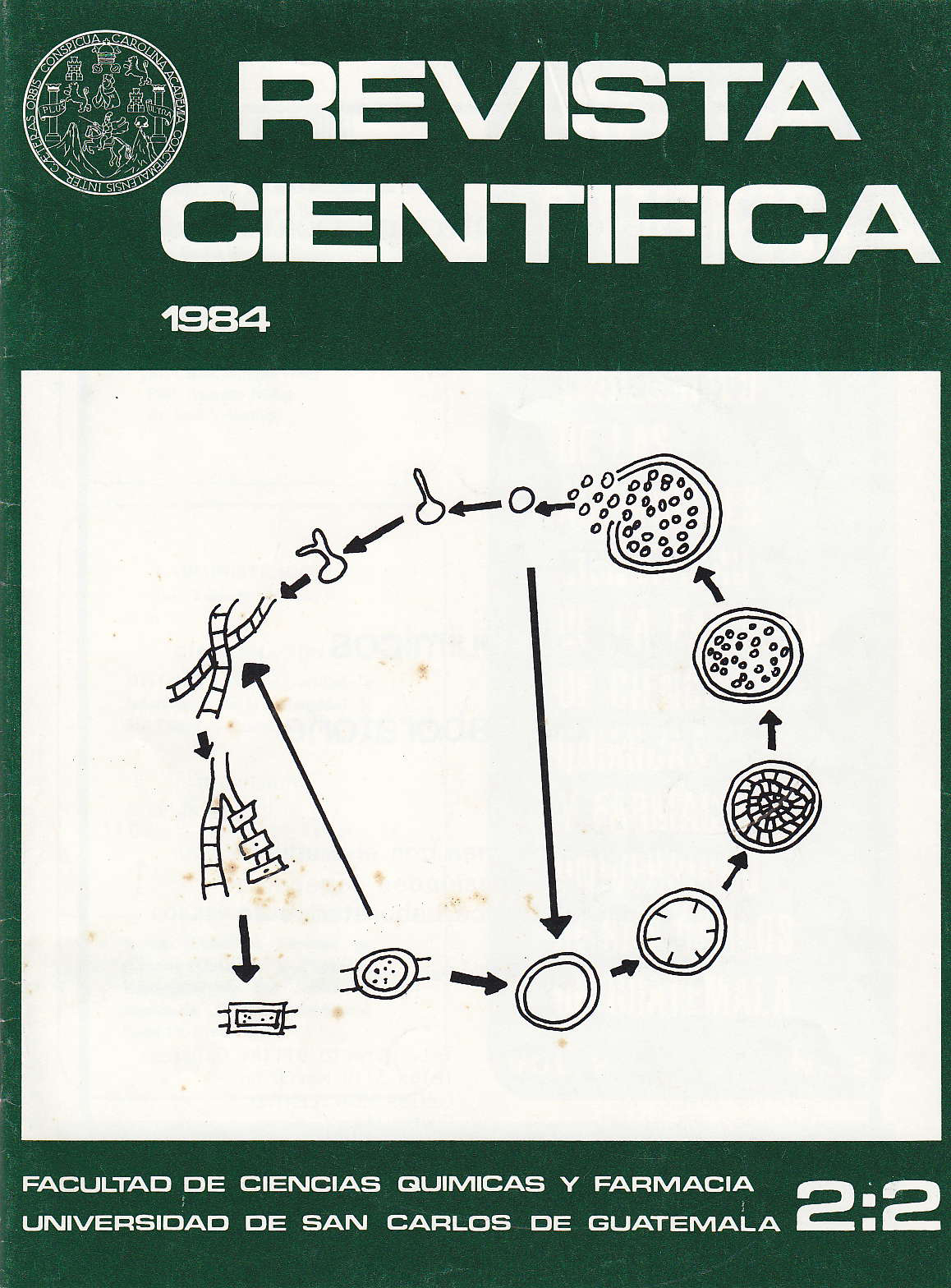Determination of the half-life of antipyran in the plasma of Guatemalan individuals and its relationship with various factors including nutritional status
DOI:
https://doi.org/10.54495/Rev.Cientifica.v2i2.469Keywords:
determination, half-life, antipyran, plasma, Guatemalan individuals, nutritional statusAbstract
The effect of malnutrition, age, sex, race, region, and body weight on the oxidative system responsible for the metabolism of many drugs, located in the hepatic macrosomes, was studied in a group of Guatemalan individuals. The plasma half-life of antipyrine, a substance metabolized by this system, was used as a parameter for this metabolism. To study the effect of these factors, two groups were used: the first consisting of 30 individuals (21 females and 9 males), ranging in age from 16 to 34 years and with adequate nutritional status; and the second group consisting of 27 individuals (13 females and 14 males), ranging in age from 16 to 35 years and with poor nutritional status. This last group was made up of individuals from various regions of the country. The group of individuals with adequate nutritional status showed lower values for antipyrine half-life, with an average of 12.2 hours (s = 2.38), while the group of malnourished individuals had an average of 20.8 hours (s = 2.38), which is 70.4 times greater than the first group. The difference between the averages was statistically significant (p > 0.05), so it can be concluded that malnutrition increases the half-life of antipyrine in plasma and consequently decreases the capacity of the hepatic microsomal oxidative system, responsible for the metabolism of many drugs, which will probably affect any other drug that is metabolized in a similar way to antipyrine. Age, sex, and body weight did not affect the half-life of antipyrine in either of the two groups studied. Race and region also did not affect this time in the malnourished group. In all cases the differences obtained were not statistically significant (p<0.5s).
Downloads
References
Litter M. Farmacología Experimental y Clínica. 6 ed. Buenos Aires: El Ateneo, 1980. XIII +- 1953 p. (p.81-117).
Lu A. Liver Microsomal drug-metabolism enzyme System: functional components and their properties. Fed, Proc. 1976; 35: 2460-2463.
Davies D, Thorgeirsson SS. Mechanism of hepatic drug oxidation and its relationship to individual differences in rates of oxidation in man. Ann N Y Acad Sci 1971; 179:411-420. https://doi.org/10.1111/j.1749-6632.1971.tb46918.x DOI: https://doi.org/10.1111/j.1749-6632.1971.tb46918.x
Fouts J, Adamson RH. Drug Metabolism in the newbom rabbitt. Science, 1959; 129:897-898. https://doi.org/10.1126/science.129.3353.897 DOI: https://doi.org/10.1126/science.129.3353.897
Fraser H. Factors affecting antipyrine metabolism in West African villages. Clin Pharmacol Ther 1977; 22:799-808. https://doi.org/10.1002/cpt1977225part2799 DOI: https://doi.org/10.1002/cpt1977225part2799
Hart P, Farrell GG. Enhanced ' Drug metabolism in cigarrette smokers. Brit Med J 1978; 2:147-149. https://doi.org/10.1136/bmj.2.1907.147 DOI: https://doi.org/10.1136/bmj.2.6028.147
Krishnaswamy K, Naidu AN. Microsomal enzymes in malnutrition as determined by plasma half-life of antipyrine. Brit Med J 1977; 1:538-540. https://doi.org/10.1136/bmj.1.6060.538 DOI: https://doi.org/10.1136/bmj.1.6060.538
Miller ON. Nutrition and drug metabolism. Introduction. Fed. Proc 1976; 35:2459.
Wade A, Norred W. Effect of dietary lipid on drug metabolism enzymes. Fed Proc 1976; 35:2475-2479.
Campbell C, Hayes JR. The effect of quantity and quality dietary protein on drug metabolism. Fed Proc 1976; 35:2470-2474.
Melander A. Influence of food on the bioavailability of drugs. Clin Pharmacol 1978; 3:337-351. https://doi.org/10.2165/00003088-197803050-00001 DOI: https://doi.org/10.2165/00003088-197803050-00001
Miranda CL, Webb RE. Effect of dietary protein on hepatic microsomal enzymes. J Nutr 1973; 103:1425. https://doi.org/10.1093/jn/103.10.1425 DOI: https://doi.org/10.1093/jn/103.10.1425
Zannoni V, Sato PH. Effect of certain vitamin deficiences on hepatic drug metabolism. Fed Proc 1976; 35:2464-2469.
Miller JL. Antipryrine plasma half-life: In-vivo indicator of oxidative metabolic capability in rhesus monkey. Pharmacology 1978; 16:279-286. https://doi.org/10.1159/000136780 DOI: https://doi.org/10.1159/000136780
Saenger P, Rifkind A, New M. Changes in drug metabolism in children with thyroid disorders. J Clin Endrocrinol Metab 1976; 42:155. https://doi.org/10.1210/jcem-42-1-155 DOI: https://doi.org/10.1210/jcem-42-1-155
Greenblatt D. Impairment of antipyrine clearance in humans by propranolol. Circulation 1978; 57:1161-1164. https://doi.org/10.1161/01.CIR.57.6.1161 DOI: https://doi.org/10.1161/01.CIR.57.6.1161
Pirttiaho HI. Liver size and indices of drug metabolism in alcoholics. Eur J Clin Pharmacol 1978; 13:61-68. https://doi.org/10.1007/BF00606684 DOI: https://doi.org/10.1007/BF00606684
Eichelbaun MG. Influence of thyroid status on plasma half-life of antipyrine in man. N Engl J Med 1974; 290:1040. https://doi.org/10.1056/NEJM197405092901902 DOI: https://doi.org/10.1056/NEJM197405092901902
Ambre J. Antipyrine metabolism and bronchogenic carcinoma. J Med 1977;8:57-70.
Tschanz C. Metabolic disposition of antipyrine in patients with lung cáncer. Cáncer Res 1977; 37: 3881-3886.
Narang R, Mehta S, Mathur V. Pharmacokinetic study of antipyrine in malnourished children. Am J Clin Nutr 1977; 30: 1979-1982. https://doi.org/10.1093/ajcn/30.12.1979 DOI: https://doi.org/10.1093/ajcn/30.12.1979
Obel OK, Vere DW. Antipyrine and propranolol disposition in malnutrition. E Afr J Med 1978; 55:1-5.
Brodie B, Axelrod J, Soberman R, Levy B. The estimation of antipyrine in biological materials. J Biol Chem 1949;25:25-29. DOI: https://doi.org/10.1016/S0021-9258(18)56807-1
Downloads
Published
How to Cite
Issue
Section
License
Copyright (c) 1984 Reyna Julieta Roca, Beatriz Batres de Jiménez, José Héctor Aguilar

This work is licensed under a Creative Commons Attribution 4.0 International License.
Authors who publish with this journal agree to the following terms:
- Authors retain copyright and grant the journal right of first publication with the work simultaneously licensed under a Creative Commons Attribution License 4.0 that allows others to share the work with an acknowledgement of the work's authorship and initial publication in this journal.
- Authors are able to enter into separate, additional contractual arrangements for the non-exclusive distribution of the journal's published version of the work (e.g., post it to an institutional repository or publish it in a book), with an acknowledgement of its initial publication in this journal.
- Authors are permitted and encouraged to post their work online (e.g., in institutional repositories or on their website) prior to and during the submission process, as it can lead to productive exchanges, as well as earlier and greater citation of published work.









